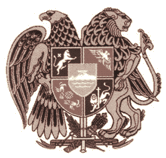

![]()
![]()
T H I R D R E P U B L I C

Written by Gevork Nazaryan
In 1988, the Artsakh Movement spread throughout Armenia like a wildfire. After years of anti-Armenian policy, pursued by the Azerbaijani authorities and with the ethnic cleansing of the last remaining Armenians in the historical Armenian Nakhichevan [that up to 1921 was part of the Republic of Armenia until it was occupied by the Turks of Azerbaijan], the Armenians of Artsakh wanted to end the discrimination policy. They pinned their hopes on the great number of reforms [perestroika - rebuilding] [glastnost - free speech] launched by the Soviet Premier, Mikhail Gorabachev. The "reforms" would in fact shake the foundations of the mighty state, bringing it crashing down in -- political terms -- "blink of an eye." The Armenians of Artsakh [Karabakh], forming the overwhelming majority of that land, wanted to see the reversal of the great historic injustice, when in 1923, the then Central Committee member Josef Stalin, placed Armenian Karabakh, with a 95% Armenian majority within Azerbaijan, as an AO - [Nagorno or Mountainous Karabakh] Autonomous Oblast [province].

T H E A R M E N I A N T R I C O
L O R
SYMBOLIC OF THE TRIPLE DECKER UNIVERSE
RED [SUN-ASTRAL LIGHT] -- BLUE -- [SKY - AIR] -- ORANGE -- [EARTH
- WHEAT]
ALSO -- RED - [FIRE -- MALE -- SUPERNATURAL] --
BLUE [WATER -- FEMALE -- NATURAL] --
ORANGE [RED + YELLOW -- SUN -- SPIRIT -- ETHEREAL]
THE FLAG WAS ADOPTED BY THE FIRST REPUBLIC IN 1918 FROM
THE ANCIENT ARMENIAN HERALDIC TRADITION GOING BACK TO THE DAWN OF HISTORY

ONE OF THE MANY FOUNTAINS OF THE CAPITAL
The Artsakhtsis knew too well what happened to another historic Armenian province of Nakhichevan...This historic Armenian land [where the great Armenian city of Old Julfa is...with its medieval cemetery of thousands of khachkars of international significance -- formed an important part of human culture and human heritage -- only to be destroyed...bulldozed and broken down to shreds with sledge hammers with remnant pieces dumped into the Arax river by hundreds of Azeri 'soldiers'...IN THE OPENING YEARS OF 21ST CENTURY...BY THE AZERBAIJANI GOVERNMENT -- a loss that is not easily described in words... and the international community -- just as in the case of the destruction of the Buddhas of Bamiyan by the Taliban regime -- just watched...from a far...without even words of condemnation...the destruction of the Buddha statues -- without any intervention -- greatly encouraged the Azerbaijani authorities in mimicking the same barbaric pattern in the destruction of the thousands of priceless khachkars of Old Julfa]. After the Azerbaijani government took over Nakhichevan [after the declaration by the Same Soviet Azerbaijani government that it recognized Armenian populated Nakhichevan and Karabakh as integral parts of Armenia] it began a systematic ethnic cleansing program which by the 1960s cleansed the overwhelming Armenian population [last remnants of Armenians forcibly removed in 1988].
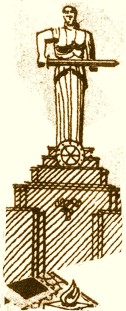
UNDER THE WATCHFUL EYE OF M O T H E R
A R M E N I A
ABOVE THE ETERNAL FLAME GUARDING HER SONS AND DAUGHTERS
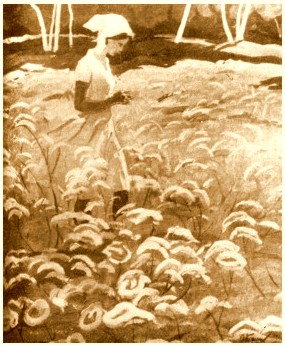
ARMENIAN GIRL AS THE SYMBOL OF LIFE AND PERSEVERANCE...
Here it is very important to note that in many respects the Armenian people have not properly healed and recuperated from this very deep wound due to the persistent and shameful denial of the genocide -- by the Turkish government -- that continues to this very day. The Turkish government of today is a direct accomplice to the crime of genocide, since it has chosen to deny [and thus become an accomplice to the crime of genocide -- since according to the U.N. declaration on Genocide -- denial is the the last stage of genocide...] rather than admit what the previous Turkish government has done. Only after admitting the darkest chapter in its history, will Turkey be able to redeem itself in the eyes of the Armenian victims and indeed collectively the international community that has time and again condemned the Turkish government for the ongoing denial and has stressed the fact that if Turkey wants to join the family of
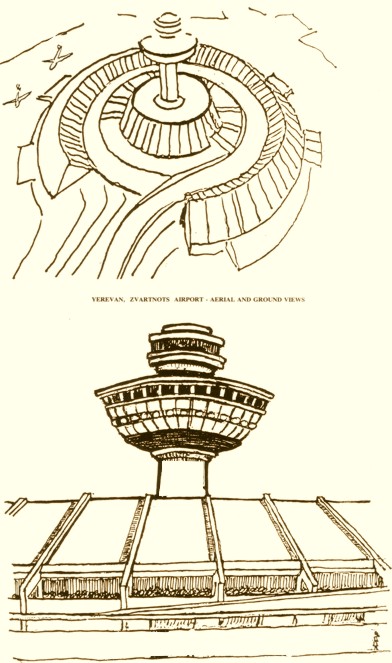
ZVARTNOTS INTERNATIONAL AIRPORT IN THE SUBURBS OF YEREVAN.
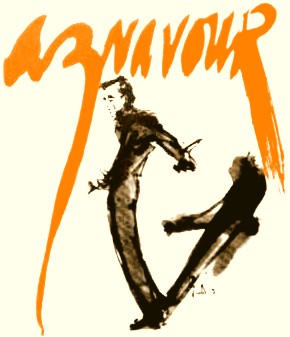
CHARLES AZNAVOUR. THE ICON OF FRANCE AND
ARMENIA.
'I AM 100 % FRENCH...I AM 100% ARMENIAN' NOTED THE
UNSURPASSED CHANSONNIER OF MELANCHOLICALLY ENCHANTING LOVE.
INDEED...THAT DEEP SEATED LOVE WITH A TINGE OF MELANCHOLY
LIKE THE WIDE EYES...THE WINDOWS TO THE DEPTHS OF THE ARMENIAN SOUL
ARE TRADEMARK ARMENIAN ATTRIBUTE. THE SQUARE IN FRONT OF THE MOSCOW
MOVIE THEATRE IN YEREVAN CARRIES THE NAME OF THE LEGEND.
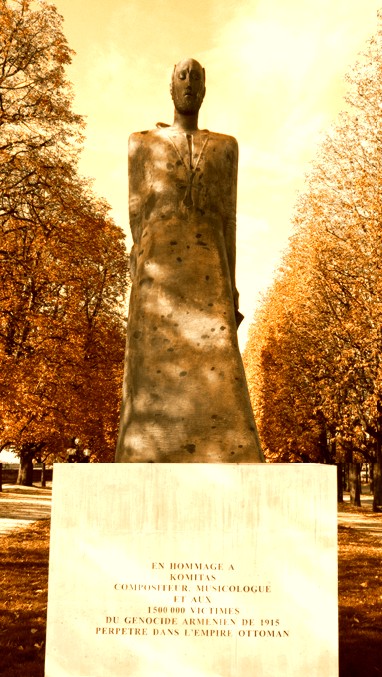
THE STATUE OF IMMORTAL KOMITAS VARTAPET IN THE HEART OF
PARIS --
PLACE DE CANADA. FROM THE HEART OF THE FRENCH PEOPLE IN MEMORIAM OF
THE 1.5 MILLION INNOCENT MARTYRS OF THE ARMENIAN GENOCIDE.

WOMAN RESTING. JANSEM.
civilized nations it must come clean with its bloody past. As the EU leadership has told the Turkish government time and again -- reforms in the political sphere, include changes in the socio-political sphere and removal of the Turkish military junta that has virtual supremacy over the civilian government. Also, implementation of a number of reforms that would strengthen democratic standards and institutions within Turkey, that are essential for initiating a dialogue for a possible EU membership [which remains Turkey's obsession -- forming the single most important foreign policy of the Turkish government]. When Turkey admits the genocide it can finally show to the world that it has indeed transformed into a modern country and finally cut with its past -- the ghost of the country widely regarded as the "sick man of Europe" will be forever put to rest.
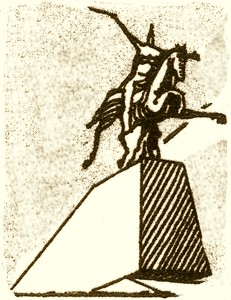
THE STATUE OF V A R D A N M A M I K O N E A N
IS LOCATED NEAR
THE ST. GREGORY THE ILLUMINATOR CATHEDRAL
The Armenians of Karabakh began peaceful rallies of democracy for the right of self-determination and national unity of Armenian Artsakh with the Motherland. The Armenian population of Artsakh -- overwhelmingly Armenian -- voted in the Supreme Soviet of Karabakh for the unification of the Nagorno Karabakh Autonomous Oblast, with Armenia. Peaceful demonstrations, in support of the just decision took place in Yerevan, where millions gathered to voice their support in order to see that justice prevails. The Azerbaijani government answered the peaceful demonstrations with -- the demonstration of brute -- and acts of unspeakable savagery. Azeri mobs, instigated by the authorities, organized large scale pogroms of Armenians living throughout the territory of Azerbaijan, by far the most gruesome massacre taking place in the city of Sumgait in late February of 1988. Here, the Azerbaijani Turkish thugs armed with everything from automatic rifles to screwdrivers, attacked Armenian homes [with lists of Armenian houses provided by government officials] killing, raping and plundering Armenian citizens. Only after three days of the bloodbath, the National Guard units, sent by Moscow's central authorities, moved in and thus ended the massacre of Sumgait.
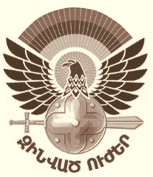
COAT OF ARMS OF THE RA DEFENSE FORCES
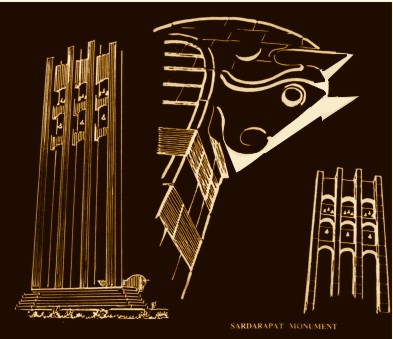
SARDARAPAT MEMORIAL ERECTED IN 1968 TO COMMEMORATE THE
50TH ANNIVERSARY OF THE VICTORY OF ARMENIAN HEROIC DEFENDERS
WHO FOUGHT AND WON AGAINST NUMERICALLY OVERWHELMING FORCES
OF THE THOROUGHLY EVIL AND INHUMAN DEATH SQUADS OF THE
TURKISH 'SPECIAL ORGANIZATION' SET UP BY THE TURKISH GOVERNMENT
TO ENTIRELY EXTERMINATE THE ARMENIAN PEOPLE...
THE LIFE AND DEATH STRUGGLE WAS WON BY THE SUPERHUMAN COURAGE
OF THE SONS AND DAUGHTERS OF A NATION THAT WAS ON
THE BRINK OF ABSOLUTE EXTINCTION...
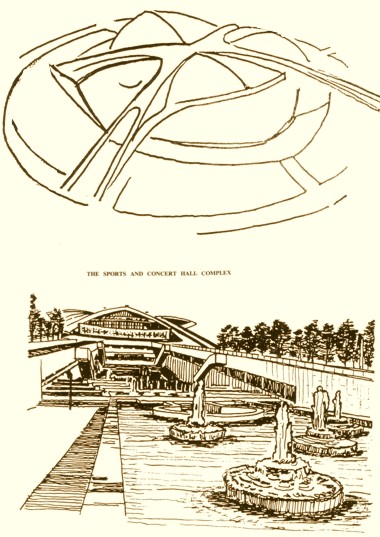
HAMALIR. THE SPORTS AND CONCERT HALL COMPLEX
STANDING NEXT TO THE GENOCIDE MEMORIAL...

THE CONCERT HALL OF THE HAMALIR.
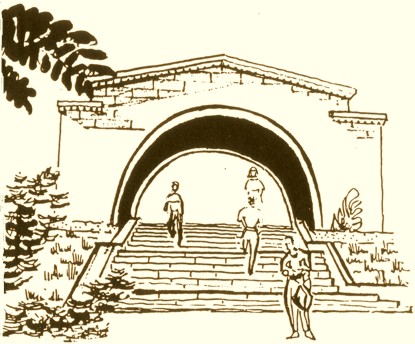
THE ARCH OF THE EŁIŠĒ Č‛ARENC‛
MEMORIAL

THE BREATHTAKING VIEW ONTO THE COSMIC MOUNTAIN FROM THE MEMORIAL.
Again, bitter and in many ways still fresh memories of Turks spilling Armenian
blood, further escalated the situation causing more pain on the open wounds.
Many Armenians cried out for vengeance and retaliation. Defense forces were
quickly organized. Later on these self-defense units became the nucleus of the
Armed Forces. The Armenian freedom fighters fought numerous battles against
Azeri invaders, thus saving many Armenian towns and villages from massacre and
ethnic cleansing. In early 1990s the Azerbaijani government had decided to
"solve" the "new Armenian Question" by using the time tested Turkic tactic of
attack, intimidation and fear -- through the means and use of military force.
The Azerbaijani forces, targeted specifically the Armenian civilian population,
by virtually constant bombardment of Stepanakert, the capital of Mountainous
Artsakh, near the historic Armenian town-fortress of Shushi -- a town which in
1920 was the scene of a widespread massacre of the Armenian population by the
Azerbaijani Tartars [Turks of Azerbaijan]. The Azerbaijanis also used the
strategic hilltops that formed a circle around Mountainous Artsakh as turrets
and directed their artillery barrage of katyusha ['grad'] rockets toward the
civilian housing complexes.
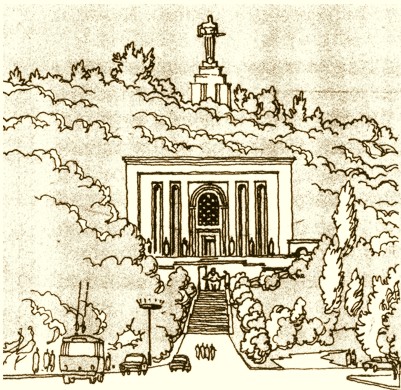
T H E M A T E N D A R A N -- T H E
H O U S E O F W I S D O M
The Azeri "soldiers" targeted women and children in order to break the heroic spirit of the highlanders of Artsakh. Not only these criminal tactics of targeting non combatants did not work, it created unlivable environment for the Armenians of Artsakh, thus forcing the freedom fighters to move in and neutralize the Azeri turrets. One by one the Azeri turrets that spewed death, were shut out. Armenian forces overran Azeri positions in Mountainous Artsakh and moved in to close the gap between Armenia and Artsakh in the Kashatagh [Lachin] region. One of the most heroic pages in the National Liberation Movement of Artsakh was the liberation of the ancient Armenian fortress-city of Shush. The Defense Committee of Karabakh, organized and mapped out the strategy for the battle.
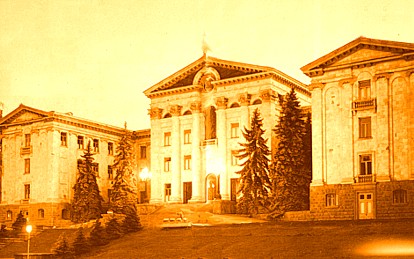
NATIONAL ASSEMBLY OF RA
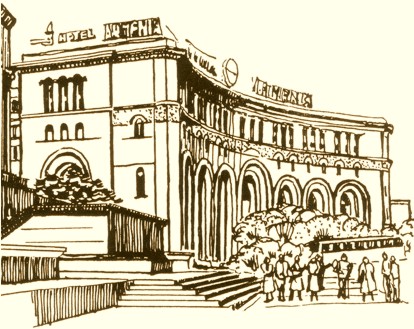
THE FIVE STAR BEAUTIFUL HOTEL ARMENIA IN THE REPUBLIC SQUARE
BUILT IN THE TRADITIONAL SACRED ARMENIAN ARCHITECTURE
PART OF AN ECLIPTIC ENSEMBLE THAT WITH ADJOINING BUILDINGS
FORMS COMPLETE HARMONY IN THE HEART OF THE CAPITAL.
ALL OUTSTANDING EDIFICES ARE DECORATED WITH
INTRICATE AND SUBLIME ETERNAL ARMAN SYMBOLS
REPRESENTING THE SACREDNESS OF LIFE AND ETERNITY.

A Y A IN THE ETHNOGRAPHIC MUSEUM
IN SISEAN, SYUNIK [SIWNIK‛]
PROVINCE.
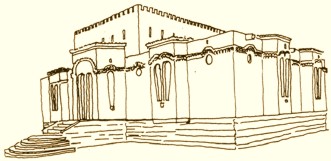
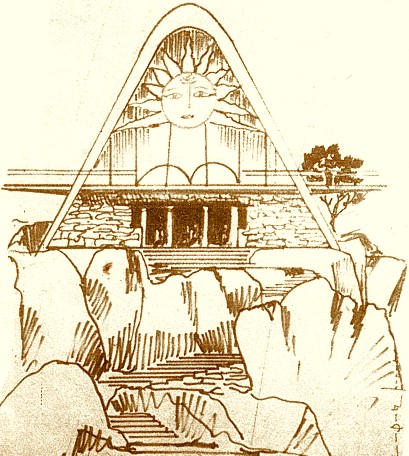
THE CAPITAL IS RENOWNED FOR ITS NUMEROUS CAFÉS
THROUGHOUT THE CITY.
SKETCH OF CAFÉ A R U S E A K [VENUS].
On May 9 [on the V-Day of WWII], 1992 Armenian forces with a loss of only few dozen men, managed to liberate the seemingly impregnable fortress of Shushi. Once again the city of Shushi [which in early part of the XXth century was one of the cultural, social and industrial thriving centers of Armenia] was part of free Artsakh. For the first time Armenians felt that it is they who must protect their own interests and their destiny and not rely on some Russian soldiers or even count on Western help and intervention -- this was the scenario at the beginning of the XXth century by the end of the XXth century the Armenians had learned the bitter lesson the hard way].
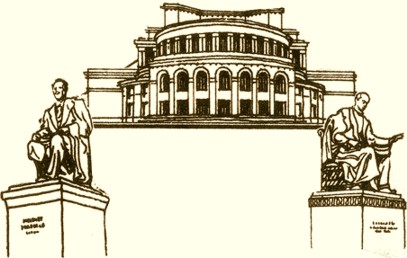
T H
E O P E
R A H O
U S E
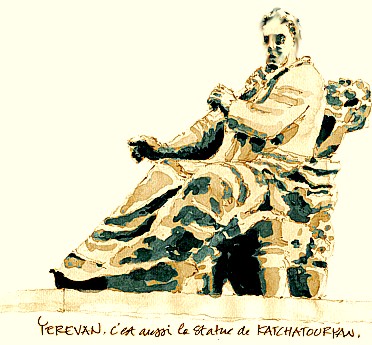
THE STATUE OF ARAM KHACHATURIAN IN FRONT OF THE OPERA
HOUSE.
THE MAIN CHAMBER HALL OF THE OPERA IS NAMED AFTER THE WORLD
RENOWNED COMPOSER.
Children, women and elders, that were hiding in shelters in Stepanakert, could for the first time freely walk the streets of Stepanakert without the fear of being killed and bombarded by Azeri mortar fire. The Karabakh Committee, formed for the unification of Artsakh with the Motherland in Yerevan, in 1989, evolved into the Armenian National Movement, led by Levon Ter-Petrosyan. In the Supreme Soviet elections of Armenia in August of 1990, LTP was elected as the Parliament's chairman. In November of 1991, Ter-Petrosyan was elected by a popular vote of more than 80% as the first popularly elected President of the Republic of Armenia [RA]. On September 23,
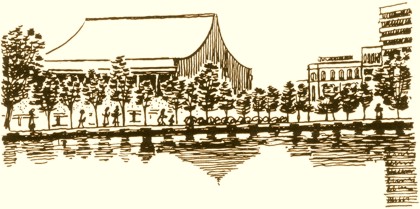
1991, RA proclaimed its independence after a democratic referendum [held two days earlier -- on September 21 -- the official Day of Independence] in which more then 99% of voters marked YES on their ballots for independence of Armenia -- thus marking the beginning of the era of the Third Republic, another milestone in the millennia long history of the Armenian people. In 1998 the succeeding President of the Third Republic became Robert Kocharyan, who previously held the post of the President of the Mountainous Artsakh and subsequently the Prime Minister of RA. Robert Kocharyan was re-elected for a second term in 2003.

V I E W F R O M A B O V I A N S T R E E T
Today Yerevan is the Capital of Armenia...Once again -- Reborn out of its own ashes -- a thriving cultural and industrial center. Yerevan is without a doubt, the heart, the mind, as well as the symbol of collective hopes, dreams and aspirations of the Armenian people worldwide.